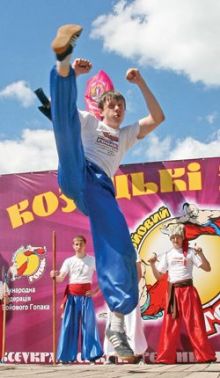Cossack Fun participants showed the revived art of ancient warriors, arousing incredible admiration among the visitors. The festival’s program included master classes of combat hopak specialists, the performance of a Cossack equestrian theater, an exhibition-cum-fair of apiary products and folk craft items, a Cossack song contest, and amusements for children.
The art of combat hopak is really a breathtaking spectacle. Enthusiasts did their utmost to revive this Cossack tradition, find like-minded people, and cross the national boundaries. Volodymyr PYLAT, president of the International Federation of Combat Hopak, the founder of this style, says that combat hopak is rather a difficult art and talent alone is not enough for one to maser the technique.
“Intense training was preceded by painstaking research. Combat hopak is virtually a science that reopens one of the illustrious pages of Cossack military glory. An individual must, first of all, find out the spiritual foundations and sources of Cossack customs before they can master the technique of this unique martial art based on courage and honor.
“The ranks of combat hopak masters are increasing every year. Units have been formed almost in every region, where young people have a chance to uphold the traditions of Cossack gallantry. Among those who wish to master this martial art are not only boys but also girls. Cossack squads include people of various ages: from boys and girls aged 6-7 to youths and girls aged 16-17 and over. More and more people would like to master this complicated art. Taking part in the festival were about 160 children and 15 instructors who conducted master classes in combat hopak,” Pylat says.
The forum is aimed at popularizing combat hopak, an ancient national combat art, encouraging all strata of the population to study and know Ukrainian culture, establishing an ethno-cultural environment, and organizing a family feast according to the best Ukrainian traditions.
It is just impossible not to admire the performance of courageous and skilled Cossack fellows. This technique is not hip-hop or break dance: these two are no patch on our combat hopak. This is why quite a few volunteers lined up to fill the “ranks of warriors.”
Andrii BERLINSKY, squad leader, Lviv combat hopak unit:
“There are boys aged 7 to 17 and an eight-year-old girl in our squad. We are mastering the technique of hand-to-hand combat and are learning to fight with batons, sabers, flails, and sickles. We would also like to learn to handle other weapons. Combat hopak is, above all, a self-defense art. Its goal is a fair encounter. We are studying the traditions and military glory of Ukrainian Cossacks. And, having learned to defend ourselves, we will be able to defend Ukraine, our fatherland. Among those who come here to learn martial arts are children and teenagers from not only our region but also from faraway countries, such as the United States, Canada, etc.”
Oleksandr ZAICHENKO, Patriot school of combat hopak, Rivne oblast:
“We set up our school very recently – in March 2010 to mark Taras Shevchenko’s birthday anniversary. Our pupils are divided into two – senior and junior – groups. We have managed to make considerable progress for rather short a time. We took third team place in the Open Freestyle Combat Tournament (Rivne) and won the 3rd International Festival of Combat Hopak (Rivne). Our goal is that our pupils develop, first of all, intellectually, not only physically. We begin and end every training session with a prayer. We give lectures and study the history of Cossacks. We first cultivate humaneness and only then martial skills.”
Cossack gonfalons are blazing on the Field of Songs like poppies in a field. Amateurs and professional artists are performing on stage. Audiences applaud to the Volnytsia group from Kyiv, Anatolii Palamarenko, and Oleh Kulchytsky (classic folk modern), who has brought in his own equipment, and many others. The festival also saw the launching of a second, revised, edition of the book Boiovy hopak.
“All those who wish can try to wield a saber, draw a bow, or even make a clay toy. We conceived it as a family feast in the spirit of Ukrainian traditions. Children rode horses and had fun at park amusements,” says festival director Mykola SEMCHENKO.
The exhibition-cum-fair attracted visitors with its colors and variety. Craftsmen’s products, be it blacksmithing, pottery, or woodwork, are genuine pieces of art. As for embroidered shirts, it goes without saying. You cannot but wonder that human hands are able to create this kind of beauty. The works of folk craftsmen are not just consumer goods: each of them exposes the depths of folk art because it is full of millennia-old symbols.
All those who wished it were treated to the Cossack kulish, a magic ritual dish by recipes from Ukraine’s various regions (Oleksandr Kochubei is the founder and director of the Museum of Cossack Cuisine). The fest was visited by about 10,000 people who satisfied their hearts’ desire and were imbued with a special atmosphere of overall exaltation – chivalry still is and will be living in Ukraine!







